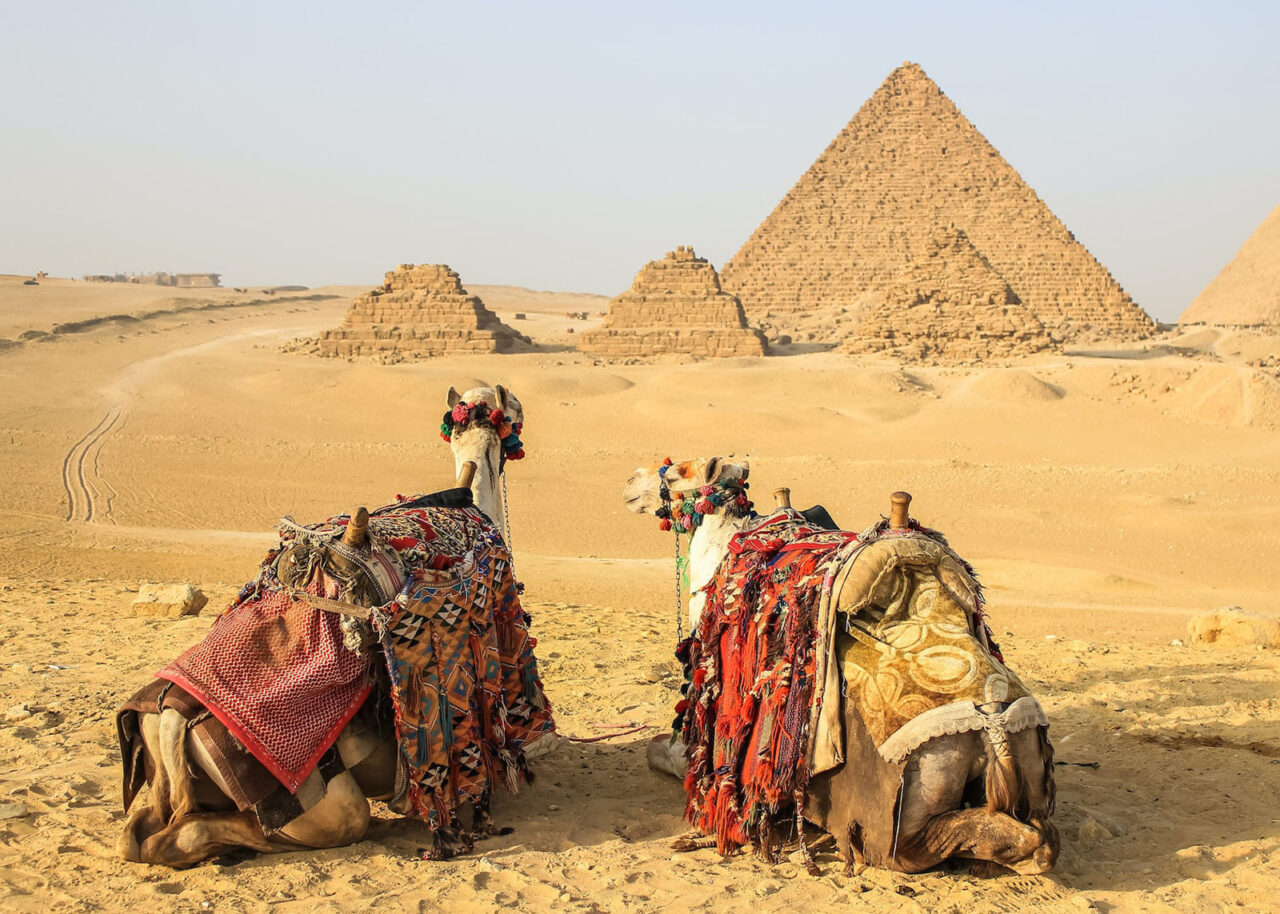Known as the cradle of civilization, Egypt is renowned for its ancient monuments and archaeological sites, such as the famed Pyramids of Giza, the Great Sphinx, and the Valley of the Kings. The country is also notable for the Nile River, the world’s longest, offering much-needed water resources and fertile land for agriculture.
Apart from its historical, architectural, and natural wonders, Egypt has made its mark in the domains of art, literature, and music. Furthermore, Egyptian cuisine, with its distinctive and flavorful dishes, has a substantial global footprint. Lastly, its prominent role in Middle Eastern politics and Arabic culture significantly contributes to its international reputation.
What Food is Egypt Known For?
Koshari

Koshari, also spelled kushari, is a staple Egyptian dish composed of rice, lentils, pasta, tomato sauce, and caramelized onions. Boasting a rich texture and glutinous starchiness, the dish is often garnished with chickpeas and crispy fried onions. Renowned for its chart-topping spice levels, Koshari offers a unique fusion of flavors and nutritional benefits. It is widely loved, not just in Egypt but throughout the world, symbolizing both the simplicity and depth of Egyptian cuisine.
Ful Medames
Ful Medames, commonly known as “ful,” is a cherished traditional dish in Egyptian cuisine. Primarily consisting of cooked fava beans served with oil, cumin, and optionally with chopped parsley, garlic, onion, lemon juice, and chili pepper. It stands as a national dish in Egypt, traditionally eaten for breakfast, but also enjoyed at any time of the day. Comforting, nutritious and hearty, Ful Medames symbolizes the culinary culture of Egypt and is an integral part of its culinary heritage.
Shawarma
Shawarma is a popular Middle Eastern dish, consisting of thinly sliced cuts of meat, such as chicken, beef, or lamb, rolled into a large piece of flatbread or pita. The meat is marinated and then slowly roasted on a vertical rotisserie. It’s typically served with various accompaniments like garlic yogurt sauce, pickles, and vegetables. Shawarma holds a staple place in street food culture and has gained worldwide recognition and appreciation for its rich, unique flavors and easy-to-eat format.
Stuffed Pigeon (Hamam Mahshi)
Hamam Mahshi, or stuffed pigeon, is a classic Egyptian dish that celebrates the country’s culinary ingenuity. The pigeon is stuffed with a flavorful mix of rice or freekeh (green wheat), herbs, and spices, then roasted to perfection. The result is a tender, juicy delicacy with a burst of flavors in every bite. Hamam Mahshi is typically served on special occasions, showcasing the Egyptian tradition of turning simple ingredients into a feast.
Kanafeh
Kanafeh is a traditional Middle Eastern dessert made of thin noodle-like pastry, or alternatively fine semolina dough, soaked in sweet, sugar-based syrup, and layered with cheese, or occasionally cream or nuts. Originated in the Palestinian city of Nablus, Kanafeh has gained popularity across the region and is much loved in Egypt. Served warm, kanafeh combines the delicate crispiness of the pastry with the warm richness of the filling, providing a unique and delectable sweet treat.
Baklava
Baklava is a delicious, traditional pastry popular in Middle Eastern and Mediterranean countries. It’s made up of thin, flaky layers of filo pastry filled with chopped nuts, such as pistachios, walnuts, or almonds, and sweetened with syrup or honey. The pastry is carefully baked until golden, providing a rich, sweet, and crunchy dessert. Though its exact origins are often debated, Baklava is appreciated worldwide for its unique texture and complex flavors that delight the senses.
Ful Wa Ta’ameya (Egyptian Falafel)
Falafel, or “Ta’ameya” as it’s known in Egypt, is a beloved Egyptian street food. Made from ground fava beans mixed with herbs and spices and deep-fried to golden perfection, Egyptian falafel is crispy on the outside, and soft and flavorful on the inside. This vegetarian delight is typically served in pita bread with tahini sauce, lettuce, tomatoes, and pickles, making for a satisfying meal that’s appreciated not just in Egypt, but globally.
Kofta and Kebab
Kofta and Kebab are cherished staples in Egyptian cuisine. Kofta is a type of meatball made of finely ground beef or lamb, mixed with spices and onions, and often shaped into long cylinders and grilled. Kebab, on the other hand, is typically cubes of marinated lamb, threaded onto skewers and grilled, delivering a deliciously charred and juicy dish. Both Kofta and Kebab are traditionally grilled over charcoal and are popular in gatherings, satisfying many with their aromatic, spiced, and hearty flavors.
What is Egypt’s Signature Drink?
Hibiscus Tea (Karkadeh)
Hibiscus tea, known as “Karkade” in Egypt, is a popular and refreshing drink with deep cultural roots. Made by steeping dried hibiscus flowers, the tea has a distinctive, vibrant red color and slight tartness, typically sweetened with sugar or honey to balance the flavor. It can be enjoyed either hot, as a soothing beverage, or cold, as a refreshing antidote to Egypt’s warm climate. Beyond its delightful taste, Karkade is also prized for its potential health benefits, like lowering blood pressure and boosting liver health.
Places Egypt is Known For
Cairo
Cairo, the bustling capital of Egypt, is a city steeped in history and cultural richness. As one of the largest cities in Africa and the Middle East, it offers an eclectic blend of ancient wonders, such as the Pyramids of Giza and the Sphinx, and urban vitality. Cairo’s vibrant markets, like the Khan El-Khalili bazaar, showcases its dynamic heritage and the warmth of its people. The city’s enchanting fusion of old and new, from stunning mosques to modern skyscrapers, cements Cairo’s place as a hub of global significance.
Luxor
Luxor, an Egyptian city on the east bank of the Nile River, is often described as the world’s greatest open-air museum. Once the ancient city of Thebes, Luxor is steeped in history and grandeur, with numerous archaeological treasures like the Luxor Temple and the Valley of the Kings. A trove of pharaonic tombs, temples, and monuments, Luxor presents a journey back into ancient Egypt’s splendor, capturing imaginations and serving as a significant site for historical and cultural exploration.
Aswan
Aswan, a serene city in southern Egypt, sits on the banks of the Nile River offering picturesque landscapes and a laid-back atmosphere. Steeped in history, Aswan boasts remarkable ancient sites like the Temple of Philae, the Unfinished Obelisk, and the Nubian Monuments. The city also features the Aswan Dam, a modern wonder that revolutionized Egypt’s water management. Celebrating its harmonious blend of natural beauty, historical significance, and Nubian culture, Aswan delivers an enchanting and unforgettable experience to those who visit.
Alexandria
Alexandria, situated on Egypt’s Mediterranean coastline, is a city with a rich historical tapestry and cosmopolitan charm. Once home to the ancient Lighthouse and the Great Library, this former Greco-Roman metropolis exudes a distinct blend of past and present. Today, visitors can explore the modern Library of Alexandria, the iconic Qaitbay Citadel, and the Catacombs of Kom El Shoqafa. The city’s vibrant culture, sandy beaches, and fresh seafood cuisine make Alexandria a captivating destination, seamlessly intertwining history, culture, and modernity.
Siwa Oasis
Siwa Oasis, located in Egypt’s Western Desert, is a tranquil and picturesque haven. This isolated Berber community, known for its unique culture and traditions, is surrounded by palm trees, olive groves, and warm sand dunes. Siwa is home to significant historic landmarks like the Temple of the Oracle, believed to be visited by Alexander the Great, and the mesmerizing Cleopatra’s Pool. Famous for its organic date and olive products and captivating natural beauty, Siwa Oasis offers a serene retreat, encapsulating a peaceful coexistence of humans and nature.
Hurghada
Hurghada, a vibrant resort city on Egypt’s Red Sea coast, is celebrated for its sandy beaches, crystal-clear waters, and thriving marine life. Renowned for world-class scuba diving and snorkeling experiences, visitors flock to explore the area’s colorful coral reefs and submerged shipwrecks. Hurghada also boasts an array of water sports, bustling beachfront promenades, and lively nightlife, catering to different tastes and interests. With its blend of relaxation and adventure, this sun-soaked destination offers a captivating escape for both thrill-seekers and those seeking coastal serenity.
Sharm El Sheikh
Sharm El Sheikh, a resort city on Egypt’s Sinai Peninsula, offers a perfect blend of natural beauty and modern luxury. Known for its coral-filled Red Sea waters, it is a diving and snorkeling paradise. The city features a variety of luxury resorts, bustling shopping areas, and vibrant nightlife. With attractions like Naama Bay’s sandy beaches and Ras Muhammad National Park’s diverse marine life, Sharm El Sheikh caters to those seeking relaxation, discovery, or adventure, making it a quintessential seaside retreat in Egypt.
Dahab
Dahab, a small town on the southeast coast of the Sinai Peninsula in Egypt, is best known as a world-class diving destination with sites like the Blue Hole. Famed for its relaxing bohemian vibe, golden sandy beaches, and breathtaking seascapes, Dahab provides a unique blend of adventure and tranquility. The city’s diverse marine life, water sports, mountaineering, and desert safaris, combined with warm local hospitality, make Dahab an unforgettable sojourn for nature-lovers and thrill-seekers alike.
Landmarks & Attractions Egypt is Famous For
Pyramids of Giza
The Pyramids of Giza, an iconic testament to ancient Egypt’s legacy, are located just outside Cairo on the Giza Plateau. This architectural marvel includes three pyramid complexes dedicated to the pharaohs Khufu, Khafre, and Menkaure. The Great Pyramid of Khufu—one of the Seven Wonders of the Ancient World—continues to astound visitors and researchers alike with its sheer scale and intricate construction. Alongside the enigmatic Sphinx, these timeless monuments offer a captivating glimpse into Egypt’s rich history, captivating the world’s imagination as they stand as an enduring symbol of human ingenuity.
Sphinx
The Sphinx, an enigmatic limestone statue located near the Pyramids of Giza, has been a symbol of mystery and intrigue for centuries. With a lion’s body and a human head—believed to represent Pharaoh Khafre—the Sphinx is among the world’s oldest and largest statues. Despite severe weathering and erosion, its timeless grandeur persists. Its origins and function remain a subject of debate amongst historians and archaeologists, adding to its allure. Overlooking the Giza Plateau, the Sphinx encapsulates the mystique and magnificence of ancient Egypt.
The Nile
The Nile River, the world’s longest river, is Egypt’s lifeline, nurturing its land, culture, and civilization for millennia. Originating from Lake Victoria and culminating in the Mediterranean Sea, its fertile banks gave rise to ancient Egypt’s civilization, providing sustenance, transportation, and a rich habitat for diverse fauna and flora. Today, it remains a central economic and socio-cultural artery, with life in Egypt echoing to the rhythm of the Nile. From captivating sunset cruises to historic site explorations, the river’s bounty continues to enchant visitors and locals alike.
Abu Simbel
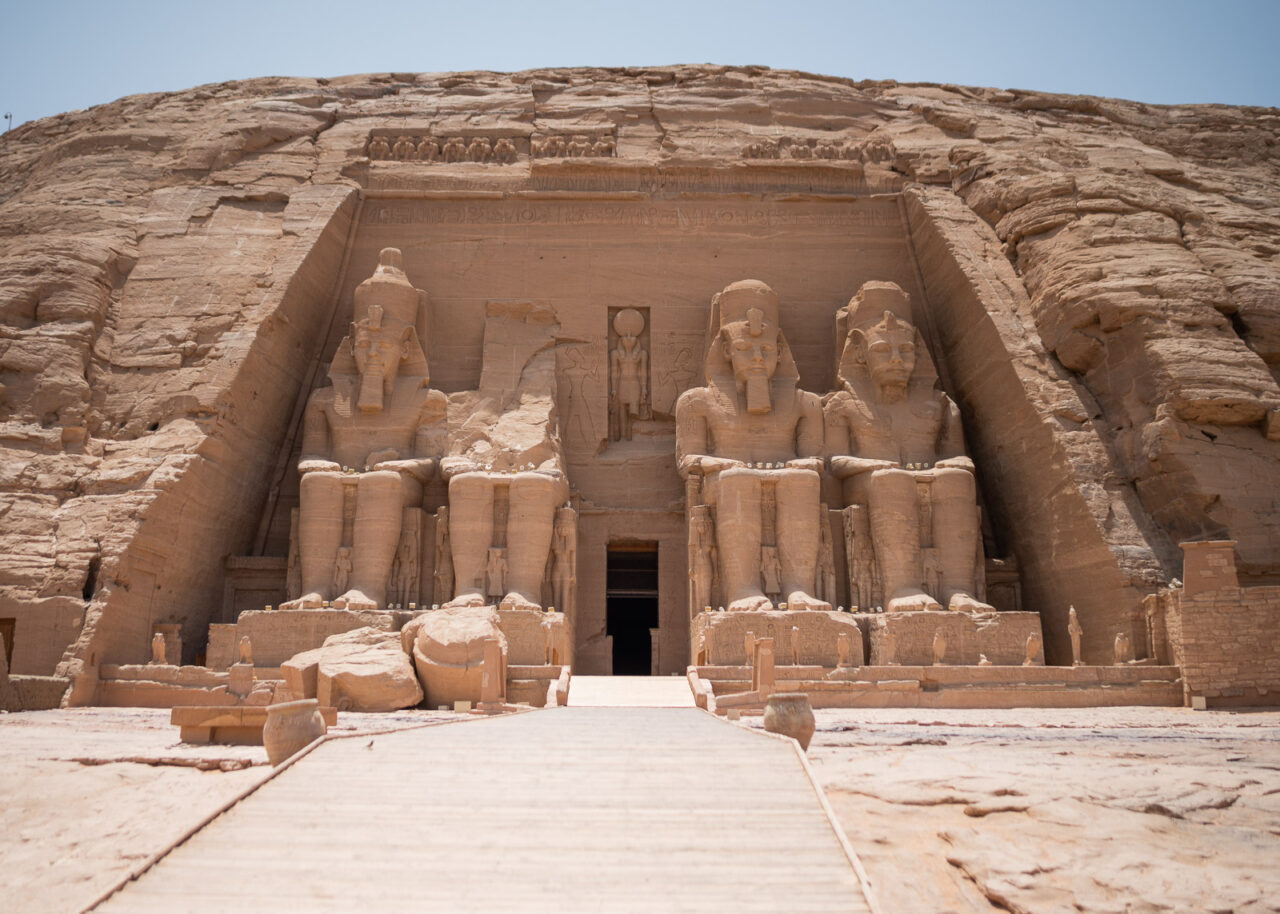
Abu Simbel, an archaeological site in southern Egypt, is home to two colossal rock temples built by Pharaoh Ramses II. These structures, adorned with imposing statues and intricate reliefs, were meticulously relocated to avoid submersion during the Aswan Dam’s construction. The temples remain testament to the grandeur of ancient Egypt. The biggest draw is the temple’s inner chamber, where twice a year, a unique solar phenomenon illuminates four statues—a dazzling spectacle that continues to draw crowds from around the world.
Valley of the Kings
The Valley of the Kings, nestled on Luxor’s West Bank, is an ancient burial site for Pharaohs and nobles of the New Kingdom period (16th-11th century BC). This necropolis houses over 60 ornately decorated tombs, including that of the famous boy-king, Tutankhamun. The sunken tombs, filled with elaborate hieroglyphics and rich relics, offer a profound window into ancient Egyptian beliefs about death and the afterlife. As an archaeologically significant site, the Valley of the Kings remains a destination of immense historical and cultural fascination.
Valley of the Queens
The Valley of the Queens, near Luxor, is an integral part of Egypt’s rich history, serving as the burial place for queens and royal children during the New Kingdom (1550–1070 BC). The best-known tomb belongs to Queen Nefertari, famed for its exquisite mural decorations. Over 80 tombs are present, many adorned beautifully; however, significantly fewer than in the Valley of the Kings. Unravelling the secrets and history of these royal women, their burial rites and stature, provides an invaluable insight into the complexity of ancient Egypt’s societal and cultural hierarchies.
The Egyptian Museum
The Egyptian Museum in Cairo houses the world’s most extensive collection of ancient Egyptian artifacts—a treasure trove of over 120,000 items. Notable for its royal mummy room and the golden riches from Tutankhamun’s tomb, the museum provides invaluable insights into ancient Egypt’s elaborate burial practices, culture, and artistry. Its collection spans from prehistoric times to the Roman period, providing a comprehensive narrative of Egypt’s history. Visiting this expansive museum is a journey into the heart of Egypt’s magnificent past.
White Desert
The White Desert in Egypt is a surreal and striking landscape, renowned for its dramatic chalk formations shaped by wind erosion over thousands of years. Situated in the Farafra depression, this immense wilderness appears moon-like, with its brilliant white, mushroom-shaped structures contrasting against the clear blue sky. During sunset, the terrain takes on a golden hue, creating a captivating spectacle. Whether camping under the stars or exploring the unique geological marvels, a visit to the White Desert is a fascinating immersion into Egypt’s off-the-beaten-path natural wonders.
Luxor Temple
Luxor Temple, situated on the east bank of the Nile in the city of Luxor, is a magnificent monument of ancient Egypt. Constructed around 1400 B.C, the temple was dedicated to the Theban Triad of Amun, Mut, and Khonsu. Its grandeur, highlighted by intricate reliefs, colossal statues, and towering obelisks, reflect the architectural prowess of the New Kingdom Pharaohs. Illuminated at night, the temple offers an enchanting spectacle. An essential part of the Luxor landscape, the temple stands as a vibrant link to Egypt’s powerful past.
Karnak Temple
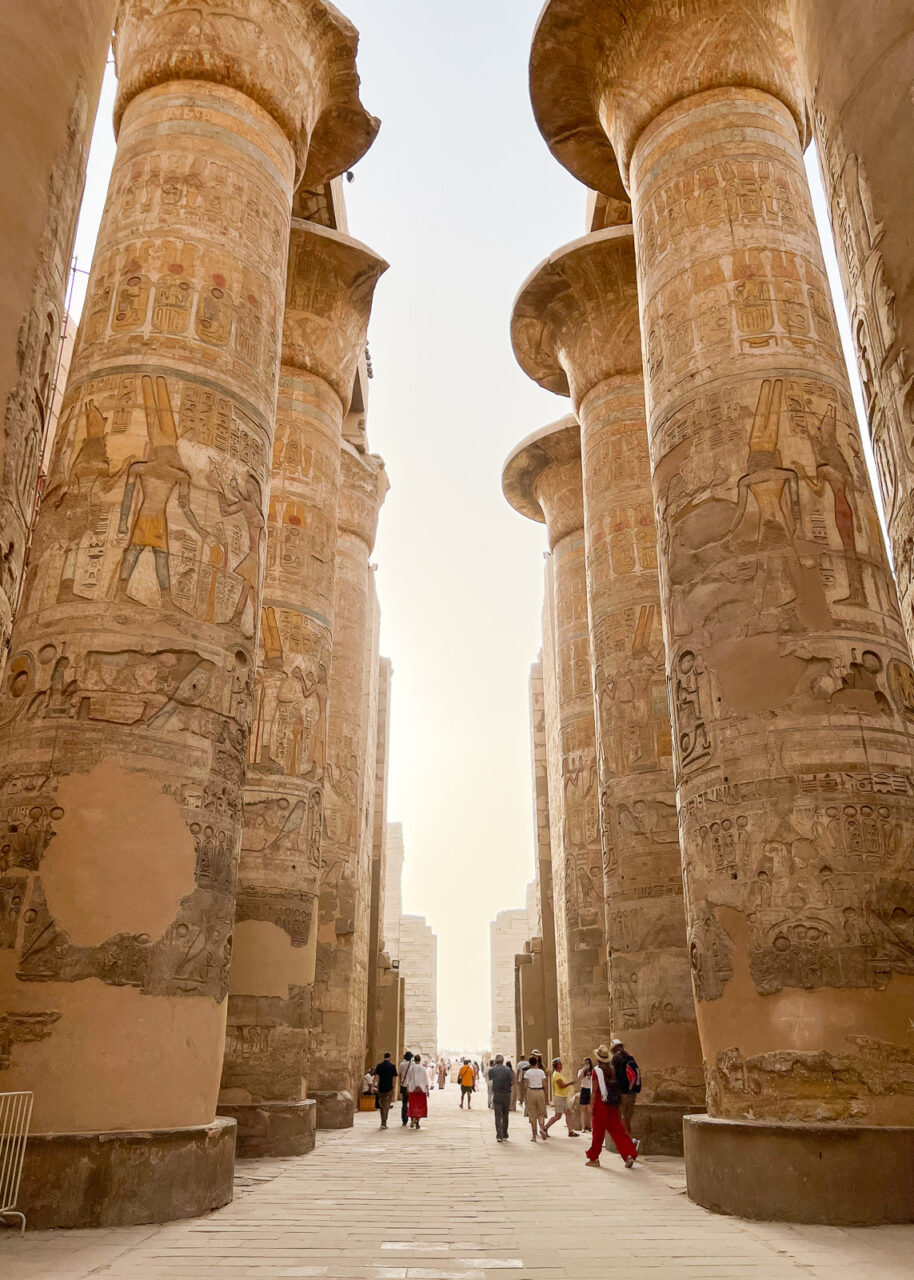
Karnak Temple, located near Luxor, is an immense complex of sanctuaries, pylons, and obelisks dedicated to ancient Egyptian gods. Built over 2,000 years, it showcases the contributions of multiple Pharaohs and symbolizes Egypt’s religious center of power in the New Kingdom. The highlight is the Hypostyle Hall, boasting 134 colossal columns. With intricate reliefs, towering structures, and a sacred lake, Karnak, often illuminated for dramatic effect, offers a profound journey into the heart of ancient Egyptian religious life. It remains an iconic testament to Egypt’s ancient architectural and spiritual prowess.
Saqqara
Saqqara, located near modern-day Memphis, is an extensive necropolis that served the Ancient Egyptian capital during the Old Kingdom. It features the renowned Step Pyramid of Djoser, the first-ever pyramid, designed by Imhotep, who would later be recognized as a god of wisdom and medicine. Saqqara is home to countless mastabas and tombs filled with intricate carvings and vividly painted scenes, shedding light on ancient Egyptian customs and beliefs. As one of the richest archaeological sites in Egypt, Saqqara offers a unique glimpse into the lives and deaths of Egyptian nobility and their eternal quest for an afterlife.
The Red Sea
The Red Sea, one of the world’s most intriguing bodies of water, provides a haven for a rich diversity of marine life. Renowned for its vibrant coral reefs and clear, warm waters, it attracts snorkelers and divers worldwide. Straddled between Africa and Asia, it holds significant historical and geographical significance, with the Suez Canal providing a vital connection to the Mediterranean Sea. Whether admiring its stunning sunsets, exploring its pristine beaches, or delving beneath its waves, the Red Sea offers a remarkable blend of natural beauty and cultural intrigue.
Temple of Hatshepsut
The Temple of Hatshepsut, nestled beneath the cliffs at Deir el-Bahari near Luxor, is an awe-inspiring tribute to Egypt’s first female Pharaoh. This striking terraced temple, with its colonnaded porticos and distinctive architectural design, represents Hatshepsut’s devotion to her father Amun, and highlights her ascent to power. The site features detailed reliefs depicting Hatshepsut’s divine birth, the expedition to Punt, and extensive renovation works. Set against a dramatic desert backdrop, the Temple offers a stunning portrayal of one of ancient Egypt’s most intriguing rulers and the delicate balance of authority and religion she navigated.
Nubian Village
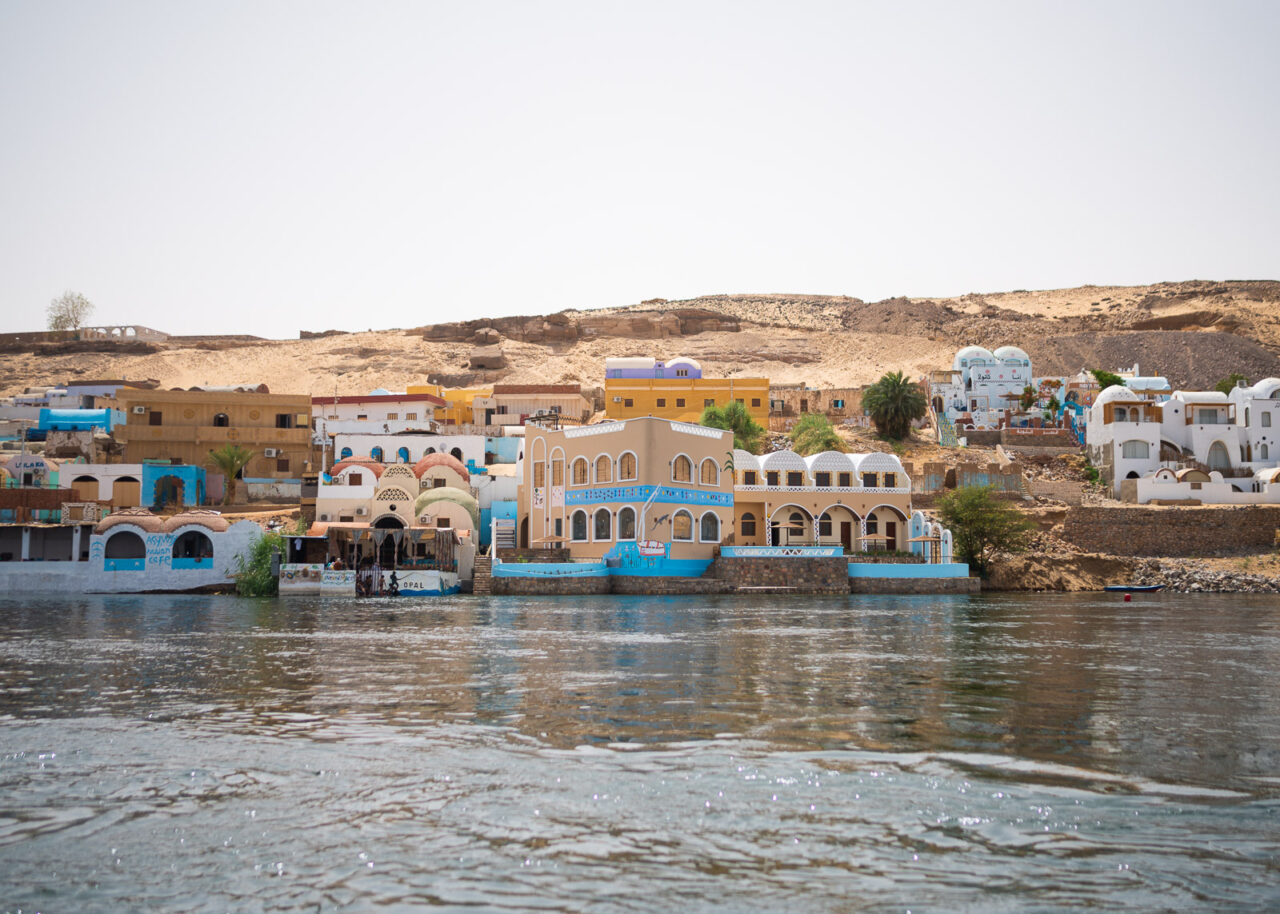
Nubian Village, nestled along the Nile near Aswan, showcases the rich culture and warm hospitality of Egypt’s Nubian people. Known for their vibrantly painted houses in shades of blue, green and yellow, the village is a feast for the eyes. Visitors can engage with the community’s distinct traditions, music, and crafts, while savoring local cuisine. The village, with its captivating blend of ancient customs and tranquil Nile-side lifestyle, offers a delightful insight into the enduring Nubian culture, a testament to the vibrant multicultural fabric of Egyptian society.
Philae Temple
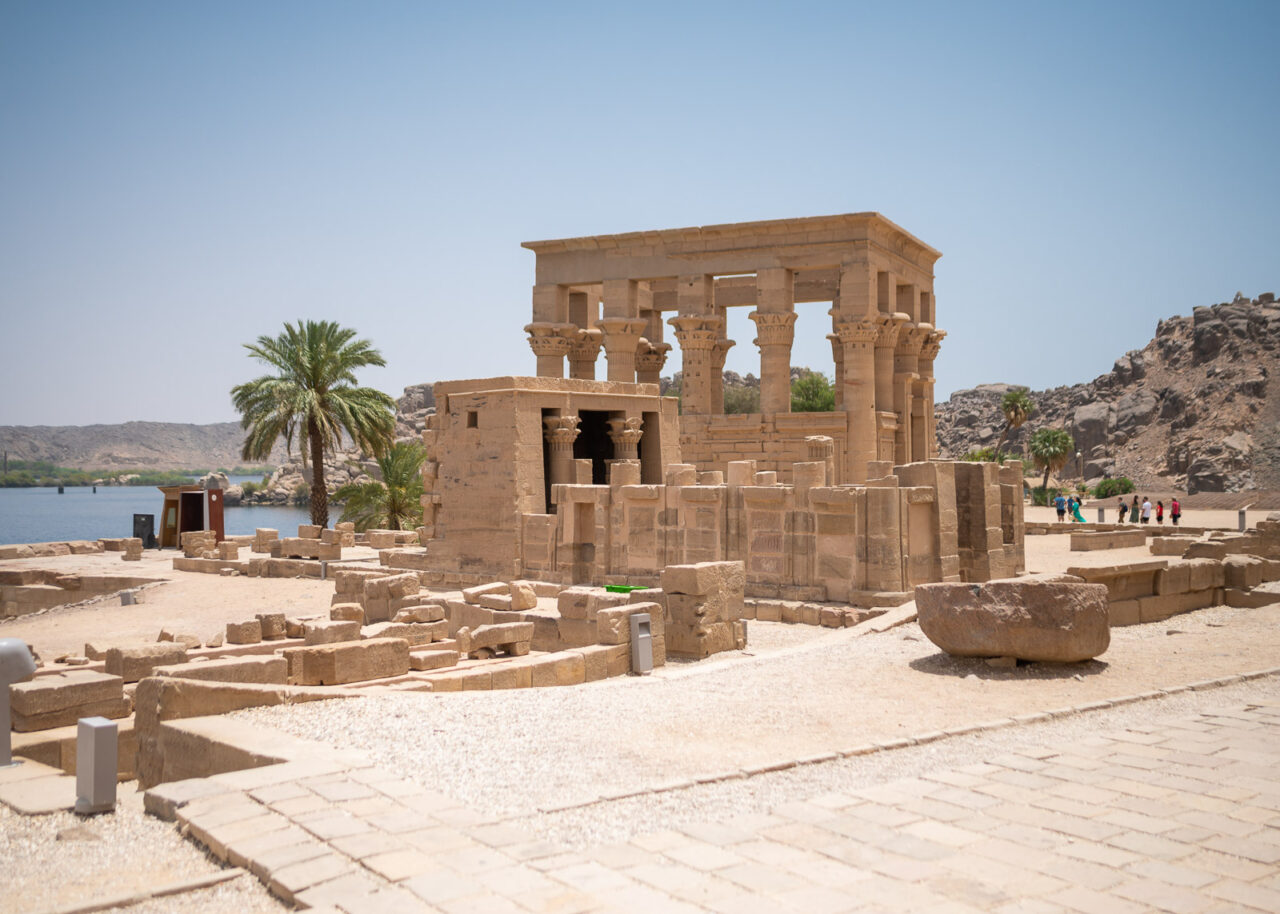
Philae Temple, perched on an island in the Nile near Aswan, is a fascinating monument dedicated to the goddess Isis. The temple complex showcases remarkably preserved Greco-Roman architectural design, with grand pylons, detailed carvings, and captivating reliefs of Isis, Osiris, and their son Horus. With its magical setting amidst Nile waters, the lit temple offers enchanting night-time visits. Constructed over hundreds of years under Ptolemaic and Roman rulers, Philae Temple represents religious continuity and adaptation, embodying a blend of Egyptian mythology and Greco-Roman traditions.
Kom Ombo
Kom Ombo, majestically overlooking the Nile in Upper Egypt, is a unique double temple dedicated equally to two gods: the crocodile-headed Sobek, god of fertility, and Horus the Elder. Built during the Ptolemaic dynasty, the temple’s symmetrical design represents the dual worship of these deities with mirrored sanctuaries and halls. The complex abounds with beautiful reliefs, including images of surgical instruments, suggestive of the temple’s link to healing and medicine. A short walk away, the Crocodile Museum boasts mummified crocodiles, paying homage to the animal sacred to Kom Ombo’s ancient inhabitants.
Saint Catharine’s Monastery
Saint Catherine’s Monastery, located at the foot of Mount Sinai, is one of the world’s oldest continuously functioning Christian monasteries. Founded in the 6th century by Emperor Justinian, it houses an unrivaled collection of ancient religious manuscripts, icons, and relics. As a UNESCO World Heritage site, the monastery is home to the famed burning bush that inspired God’s words to Moses, as well as the well where Moses met his wife, Zipporah. Offering striking natural beauty and rich spiritual significance, Saint Catherine’s Monastery is a sacred haven for both contemplation and historical exploration.
History, Culture & Traditions Egypt is Known For
Pharaonic History
Pharaonic history, synonymous with the story of ancient Egypt, spans over three millennia, marked by the reigns of powerful Pharaohs. Beginning with the unification of Upper and Lower Egypt by Narmer, this grand civilizational epoch boasts towering pyramids, intricate temples, and detailed burial sites that encapsulate the civilization’s profound religiosity, technological prowess and artistic achievement. Ruled by legendary figures like Khufu, Hatshepsut, Akhenaten and Tutankhamun, Pharaonic history reflects the Egyptians’ fascination with immortality, their complex pantheon of gods, and their intricate social and political structures, making it one of humanity’s most intriguing historical periods.
Mummies
Mummies, the preserved remains of the deceased, are pivotal to understanding ancient Egyptian beliefs and practices surrounding death and the afterlife. Employing complex embalming processes, the Egyptians skillfully removed organs, cleansed the bodies, and wrapped them in layers of linen, accompanied by amulets and sacred objects. Mummies often lay undisturbed in elaborately decorated tombs and sarcophagi, alongside texts guiding them through their journey to immortality. Mummification, while most closely associated with Egypt, has been practiced in various cultures worldwide, offering invaluable insights into the rites and rituals surrounding human mortality.
Nubian People
The Nubians are an ethnic group native to Northern Sudan and Southern Egypt, known for their rich history and vibrant culture. Living along the banks of the Nile, they are distinguished by their unique languages, resilient traditions, and brightly coloured architecture. Historically renowned as traders, soldiers, and skilled craftsmen, Nubians have played significant roles in the development of Sudanese and Egyptian civilizations. Despite modern challenges, Nubians are committed to preserving their cultural identity, with traditions like music, dance, and storytelling continuing to play a central role in their community life.
Hieroglyphs
Hieroglyphs are elaborate pictorial scripts used by ancient Egyptians for religious, administrative, and everyday communication. These intricate symbols, comprising over 700 different characters, blend ideographic, syllabic, and alphabetic elements and can be read from right to left or left to right, depending on where the characters are facing. Used in royal and sacred spaces, they served an essential role in preserving Egypt’s history, lore, and belief systems. The knowledge of reading hieroglyphs was lost until the decipherment of the Rosetta Stone, thereby unlocking an invaluable key to understanding ancient Egyptian civilization.
Egyptian Cotton
Egyptian Cotton, known worldwide for its unmatched quality, is a significant contributor to Egypt’s economy. This extraordinary long-fiber cotton grows in the fertile soil of the Nile Delta, resulting in threads that are exceptionally soft, strong, and breathable. The luxurious feel and durability of Egyptian Cotton make it ideal for high-end bedding and clothing. It’s also recognized as superior to other types due to its ability to produce extra-long staples, offering smoother, finer yarns. Despite recent challenges in the industry, Egyptian Cotton continues to be a symbol of quality and luxury in textile markets globally.
Petroleum and Natural Gas
Petroleum and natural gas play a vital role in Egypt’s economy, making it the largest non-OPEC oil producer in Africa and the second-largest dry natural gas producer on the continent. These resources contribute significantly to the country’s GDP and are key in domestic energy consumption. Egypt also exports significant quantities of oil and natural gas to global markets. Recent large gas discoveries, like the Zohr gas field, suggest a promising future for Egypt’s energy industry, potentially transforming it into a key global player in the natural gas sector.
Perfumes
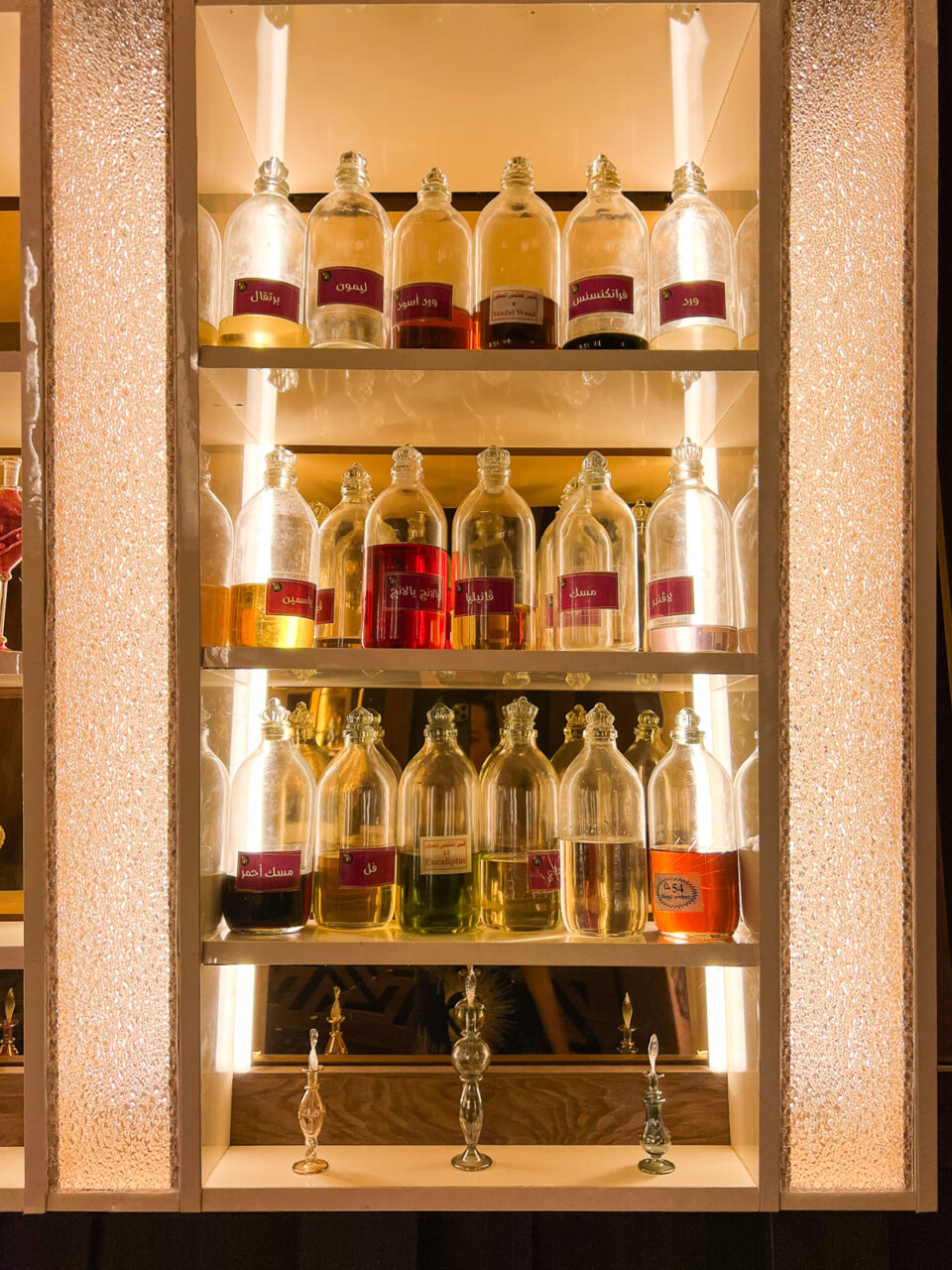
Perfumes held great importance in ancient Egyptian culture, being a symbol of social status and personal well-being. Egyptians were renowned for their elaborate perfume compositions using essential oils from flowers, fruits, herbs, and spices. Perfumes were commonly employed in religious ceremonies, as offerings to the gods, and for embalming the deceased. Oils and scented ointments were also part of everyday grooming procedures for men and women alike. The ancient Egyptians’ mastery in creating complex and long-lasting fragrances has left an enduring mark on the world of perfumery, transcending time and geography.
Famous People from Egypt
Mo Salah
Mohamed Salah, often known as Mo Salah, is an globally renowned professional footballer from Egypt. Currently playing as a forward for the Premier League club Liverpool and the Egyptian national team, Salah’s exceptional speed, skill, and scoring prowess have drawn global attention. Since his rise to prominence, he has won numerous awards including multiple Golden Boots and the FIFA Puskás Award. Salah is also celebrated for his philanthropy and advocacy work in Egypt. Regarded as one of the best players in the world, he has significantly elevated the profile of Egyptian football on the international stage.
Dodi Fayed
Dodi Fayed was an Egyptian film producer and the son of billionaire Mohamed Al-Fayed. Born in Alexandria, Egypt, Fayed moved to the UK in his childhood, later embarking on a career in the film industry, where he produced hits like “Chariots of Fire.” However, Fayed is most famously remembered for his romantic relationship with Diana, Princess of Wales. Their relationship, which sparked widespread media interest, tragically ended when they both died in a car crash in the Pont de l’Alma tunnel in Paris in August 1997, stirring global grief and a spate of conspiracy theories.
Tutankhamun
Tutankhamun, colloquially known as “King Tut,” was an Egyptian pharaoh of the 18th dynasty during the period of Egyptian history known as the New Kingdom. Ascending to the throne at the age of nine or ten, he ruled until his death around 1323 BC. While Tutankhamun’s reign was relatively uneventful, his tomb’s discovery by Howard Carter in 1922 made him a global icon due to its untouched treasures, providing unprecedented insight into the wealth, traditions and burial customs of ancient Egypt. Today, Tutankhamun remains one of the most well-known figures of ancient Egyptian history.
Cleopatra
Cleopatra VII, known simply as Cleopatra, was the last active ruler of the Ptolemaic Kingdom of Egypt. Ascending to the throne in 51 BC, Cleopatra was renowned for her intelligence, political cunning, and legendary beauty. She is notably remembered for her relationships with Julius Caesar and Mark Antony, which had significant political implications. Cleopatra’s life symbolizes the end of the Hellenistic era and the beginning of Roman domination in Egypt. Despite her tragic death in 30 BC, Cleopatra’s captivating story continues to inspire countless works of art, literature, and film, making her a timeless icon of ancient Egypt.
Omar Sherif
Omar Sharif was a prominent Egyptian actor who achieved international fame in the 1960s with roles in films like “Lawrence of Arabia” and “Doctor Zhivago,” for which he received an Academy Award nomination. Born Michel Demitri Chalhoub in Alexandria, Sharif began his career in Egyptian cinema before transitioning to Hollywood. Known for his distinctive voice, charismatic on-screen presence, and versatile acting abilities, Sharif’s groundbreaking career paved the way for other Arab actors in international cinema. Besides acting, Sharif was an accomplished bridge player, achieving world-class status in the card game.

